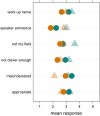Women's visibility in academic seminars: Women ask fewer questions than men
- PMID: 30260980
- PMCID: PMC6159863
- DOI: 10.1371/journal.pone.0202743
Women's visibility in academic seminars: Women ask fewer questions than men
Erratum in
-
Correction: Women's visibility in academic seminars: Women ask fewer questions than men.PLoS One. 2019 Feb 6;14(2):e0212146. doi: 10.1371/journal.pone.0212146. eCollection 2019. PLoS One. 2019. PMID: 30726301 Free PMC article.
Abstract
The attrition of women in academic careers is a major concern, particularly in Science, Technology, Engineering, and Mathematics subjects. One factor that can contribute to the attrition is the lack of visible role models for women in academia. At early career stages, the behaviour of the local community may play a formative role in identifying ingroup role models, shaping women's impressions of whether or not they can be successful in academia. One common and formative setting to observe role models is the local departmental academic seminar, talk, or presentation. We thus quantified women's visibility through the question-asking behaviour of academics at seminars using observations and an online survey. From the survey responses of over 600 academics in 20 countries, we found that women reported asking fewer questions after seminars compared to men. This impression was supported by observational data from almost 250 seminars in 10 countries: women audience members asked absolutely and proportionally fewer questions than male audience members. When asked why they did not ask questions when they wanted to, women, more than men, endorsed internal factors (e.g., not working up the nerve). However, our observations suggest that structural factors might also play a role; when a man was the first to ask a question, or there were fewer questions, women asked proportionally fewer questions. Attempts to counteract the latter effect by manipulating the time for questions (in an effort to provoke more questions) in two departments were unsuccessful. We propose alternative recommendations for creating an environment that makes everyone feel more comfortable to ask questions, thus promoting equal visibility for women and members of other less visible groups.
Conflict of interest statement
The authors have declared that no competing interests exist.
Figures



References
-
- Damschen EI, Rosenfeld KM, Wyer M, Murphy-Medley D, Wentworth TR, Haddad NM. Visibility matters: increasing knowledge of women’s contributions to ecology. Front Ecol Environ. 2005;3: 212–219.
-
- Eagly AH, Steffen VJ. Gender stereotypes stem from the distribution of women and men into social roles. J Pers Soc Psychol. 1984;46: 735.
-
- Peters K, Ryan M, Haslam SA, Fernandes H. To Belong or Not to Belong. J Pers Psychol. 2012;
Publication types
MeSH terms
LinkOut - more resources
Full Text Sources
Other Literature Sources

